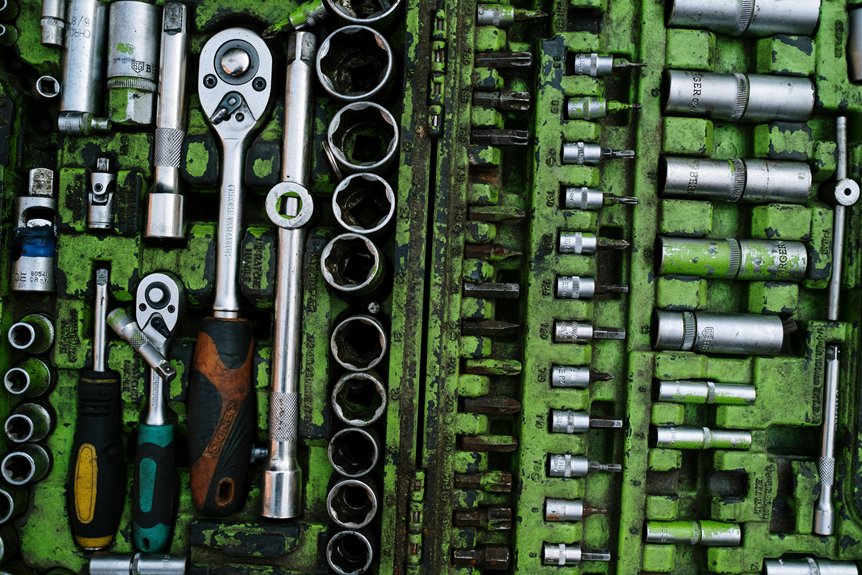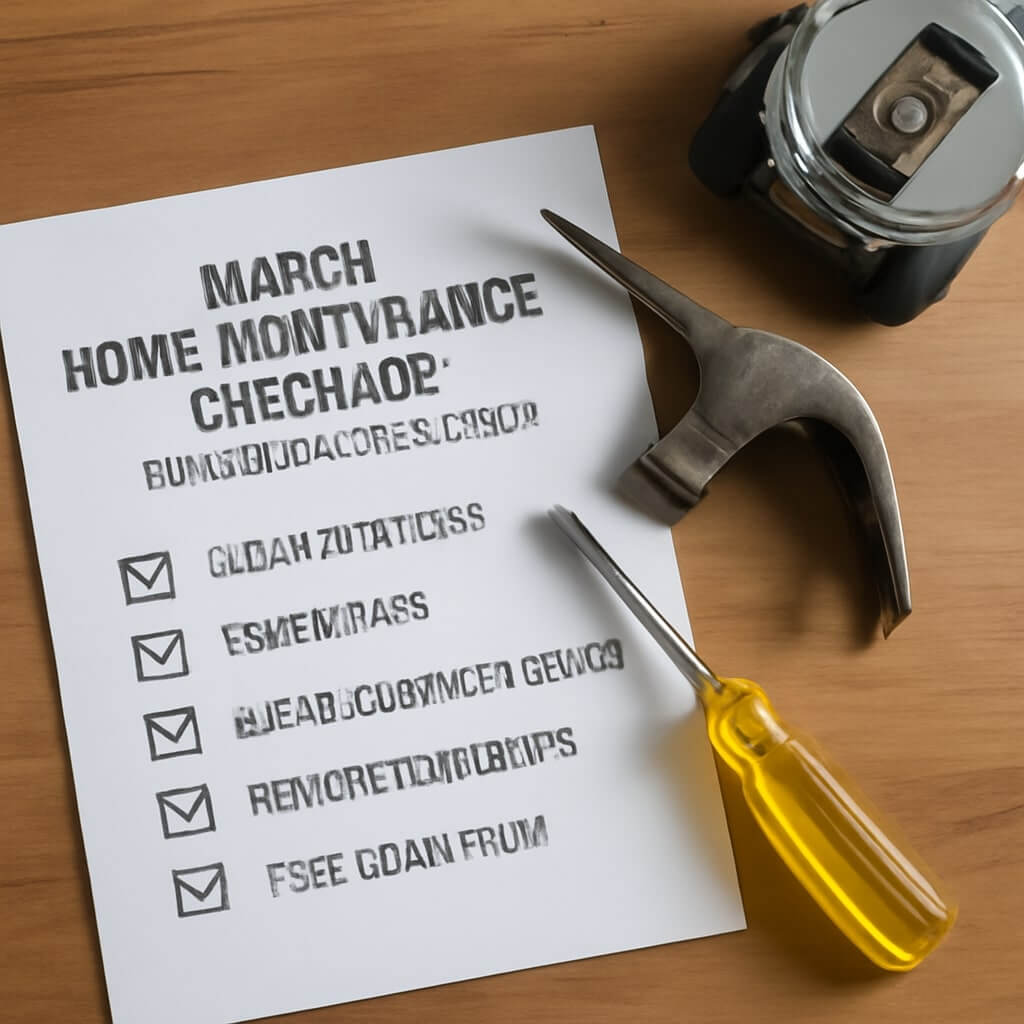Home maintenance can feel intimidating, but it doesn’t have to be. By following a few simple tips, you can keep your home in top shape without the stress. Start by creating a seasonal checklist to keep track of necessary tasks. From inspecting your roof to checking air filters, there are essential steps you can take to guarantee everything runs smoothly. Let’s explore these tips further and simplify your home upkeep.
Key Takeaways
- Create a seasonal maintenance checklist to ensure essential tasks are completed efficiently throughout the year.
- Conduct regular inspections of your roof, gutters, and smoke detectors to prevent major issues.
- Replace HVAC air filters every one to three months to maintain air quality and system efficiency.
- Deep clean your home annually, focusing on carpets, windows, and appliances to keep everything in good working order.
- Seal gaps and apply weather stripping to improve energy efficiency and reduce utility costs.
Create a Seasonal Maintenance Checklist

As the seasons change, it’s crucial to stay proactive about home maintenance to prevent costly repairs down the line.
Start by creating an organized checklist that outlines seasonal tasks. For spring, include cleaning gutters, checking outdoor faucets, and servicing your HVAC system.
Creating a seasonal checklist helps ensure essential home maintenance tasks are completed efficiently and on time.
In summer, focus on landscaping, painting touch-ups, and inspecting your deck.
Fall’s tasks might involve sealing windows, cleaning leaves, and checking smoke detectors.
Winter preparation could entail insulating pipes and ensuring your heating system is efficient.
Inspect and Maintain Your Roof
While you might not think about your roof often, regular inspections and maintenance are key to extending its lifespan and preventing leaks or damage. Schedule roof inspections at least twice a year, focusing on common issues like damaged shingles or debris accumulation. Different roofing materials require specific care, so be aware of what your roof is made of. Here’s a quick reference table:
| Roofing Material | Inspection Tip | Maintenance Action |
|---|---|---|
| Asphalt Shingles | Look for curling edges | Replace damaged shingles |
| Metal | Check for rust spots | Treat rust or repaint |
| Tile | Inspect for cracks | Repair or replace tiles |
| Wood | Watch for mold | Clean and treat wood |
| Flat | Look for pooling water | Clear drains and seal |
Check Your Gutters and Downspouts
Checking your gutters and downspouts at least twice a year is essential for maintaining your home’s integrity. Clogged gutters can lead to water damage and costly repairs.
Start by removing debris like leaves and twigs during your gutter cleaning sessions. Use a sturdy ladder for safety, and wear gloves to protect your hands.
Confirm downspouts are clear and direct water away from your foundation. If you notice any leaks or damage, address them promptly.
Regular downspout maintenance will prevent overflow and potential flooding. By keeping your gutters and downspouts in top shape, you’ll safeguard your home’s structure and longevity.
Test Smoke and Carbon Monoxide Detectors
To guarantee your home remains safe, testing smoke and carbon monoxide detectors regularly is essential.
Start by checking the placement of your detectors; they should be on every level of your home, especially near sleeping areas.
Follow the manufacturer’s testing procedures—usually, this involves pressing a button on the device. Test them monthly to confirm they’re functioning properly.
If you hear a beep or chirp, it’s working; if not, replace the batteries or the entire unit if it’s over ten years old.
Staying proactive about these tests can save lives and keep your family safe from unseen dangers.
Change Air Filters Regularly
Changing your air filters regularly is essential for maintaining good air quality and efficiency in your home.
You should replace them every one to three months, depending on usage and type.
Follow simple steps to replace them, and you’ll keep your HVAC system running smoothly.
Importance of Clean Filters
While you might not think about air filters often, keeping them clean is essential for maintaining a healthy home environment. Clean filters improve air quality, enhance HVAC efficiency, and reduce energy costs. Different filter types, like HEPA and pleated filters, require specific maintenance routines.
| Benefit | Clean Filters | Dirty Filters |
|---|---|---|
| Air Quality | Improves circulation | Traps allergens and dust |
| Energy Efficiency | Lowers utility bills | Forces systems to work harder |
| System Longevity | Extends HVAC lifespan | Causes early breakdowns |
| Comfort | Maintains consistent temps | Creates hot/cold spots |
| Maintenance Frequency | Easy to check and replace | Neglect leads to issues |
How Often to Replace
Regularly replacing your air filters is crucial for ideal HVAC performance and air quality.
Generally, you should check your filters every month, especially during heavy usage seasons. Depending on your system and filter type, you might replace them every 1 to 3 months.
If you have pets or allergies, you might need to do it more often. Staying on top of how often you change your filters can prevent costly appliance replacement and keep your air clean.
Remember, a clean filter works more efficiently, saving you energy and improving your home’s overall comfort.
Don’t overlook this simple yet important task!
Steps for Replacement
Maintaining clean air filters is a straightforward task that can greatly impact your HVAC system’s efficiency.
First, gather your tools: a screwdriver, replacement filters, and a vacuum. Before you start, make certain you wear gloves and goggles for safety.
Turn off your HVAC system to prevent any accidents. Remove the access panel using your screwdriver and take out the old filter.
Use the vacuum to clean any dust or debris in the area. Insert the new filter, making sure it fits snugly.
Replace the access panel, turn the system back on, and you’re done! Regular checks keep your air clean and your system running smoothly.
Keep Plumbing in Check
Keeping your plumbing in check is essential for preventing costly repairs.
Regularly inspect for leaks and guarantee your drainage systems are clear to maintain proper flow.
Addressing these issues early can save you time and money down the line.
Regular Leak Inspections
A few simple leak inspections can save you from costly repairs and water damage in your home. Start by checking under sinks, around toilets, and behind appliances for any signs of moisture.
Don’t forget to examine exposed pipes and your water meter for unusual readings, which can indicate leaks. Using basic leak detection techniques, like listening for dripping sounds or feeling for dampness, can help you catch issues early.
Regularly inspecting your plumbing not only prevents water damage but also conserves water and keeps your bills in check. Make this part of your routine to guarantee a healthy home environment.
Clear Drainage Systems
Regularly clearing your drainage systems can prevent major plumbing issues down the line.
Neglecting this essential drainage maintenance can lead to costly repairs and unwanted messes.
Here are some practical tips for effective clog prevention:
- Use a drain strainer: Catch hair and debris before they enter your pipes.
- Flush with hot water: Regularly pour boiling water down your drains to dissolve grease and buildup.
- Avoid chemical cleaners: These can damage your pipes; instead, try natural solutions like baking soda and vinegar.
Don’t Neglect Your Yard and Landscaping

While it might be easy to overlook your yard and landscaping amidst a busy schedule, neglecting these areas can lead to bigger problems down the road.
Regular yard maintenance is essential for maintaining curb appeal and preventing issues like pests and overgrowth. Start by mowing your lawn weekly and trimming hedges monthly.
Regular yard maintenance is crucial for curb appeal and to prevent pests; mow weekly and trim hedges monthly for best results.
Incorporate landscaping tips like planting native plants that require less water and care. Don’t forget to mulch to retain moisture and suppress weeds.
Schedule seasonal clean-ups to keep your yard looking its best. A well-maintained yard not only enhances your home’s value but also provides a relaxing outdoor space for you.
Conclusion
By following these seven essential home maintenance tips, you can keep your home in great shape without feeling overwhelmed. Creating a seasonal checklist and regularly inspecting key areas will help you catch issues before they become costly problems. Don’t forget to change air filters and test detectors to guarantee safety and efficiency. With a little effort and consistency, you’ll maintain a comfortable, energy-efficient home that you can enjoy for years to come.



